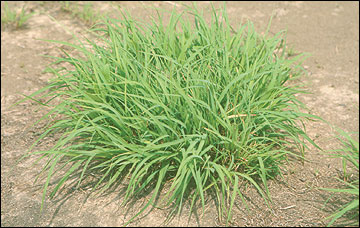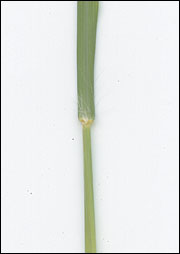Old World bluestems, e.g., Caucasian bluestem (Bothriochloa bladhii (Retz.) S.T. Blake)
Warm-season grasses
The Old World bluestems are a group of warm-season grasses imported from Russia. They are not related to native bluestems such as big and little bluestems. Caucasian bluestem is the most commonly grown Old World bluestem and finds its widest use in southern Missouri. Caucasian bluestem tolerates heavy grazing; in fact, for forage quality to be acceptable for dairy cows, caucasian bluestem must not be allowed to grow taller than 6 inches. It is also winter-hardy and easier to establish than many other warm-season grasses. It tolerates shallow and infertile soils better than many other species. However, caucasian bluestem is best grown by itself because of its aggressiveness. It does not grow well on poorly drained soils. Finally, its nutritive value plummets if it is not well fertilized with nitrogen or if it is permitted to form seed heads.
 Old World bluestems
Old World bluestems
 Yield distribution of Old World bluestems in Missouri.
Yield distribution of Old World bluestems in Missouri.
- Origin: Russia
- Adaptation to Missouri: Southern half of Missouri
- Growth habit: Nearly sod-forming, perennial bunchgrass.
- Blade: Glabrous, prominent midrib, taper to a fine point.
- Sheath: Smooth, slightly keeled.
- Ligule: Inconspicuous, fringed membrane.
- Auricles: Absent.
- Seed head: Elongated panicle, pale green to purplish, axis longer than branches.
- Fertilization: 50 lb N/acre in spring when grass is 3 to 5 inches (mid-May). Apply another 50 lb N/acre every 30 to 40 days thereafter. Phosphorus and potassium to soil test.
- Burning management: Every year or two, in early spring before any new growth is present (early April).
- Timing of production: Late May through mid-September.
- When to begin grazing: When grass is 6 inches tall.
- When to cut for hay: Late boot stage
- Lowest cutting or grazing height: 2 inches
- Fall management: Do not hay or graze after Sept. 30.

